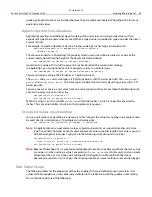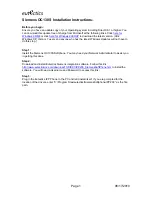
Photoshop CS2
Adobe Photoshop CS2 Scripting Guide
Scripting Photoshop CS2 57
Stroking the Selection Border
The following examples use the
stroke (Stroke/stroke())
command/method of the
Selection
object to stroke the boundaries around the current selection and set the stroke color and width.
Note:
The transparency parameter cannot be used for background layers.
AS
stroke selection of current document using color ¬
{class:CMYK color,cyan:20, magenta:50, yellow:30, black:0}¬
width 5 location inside blend mode vivid light opacity 75 ¬
without preserving transparency
VBS
selRef.Stroke strokeColor, 5, 1, 15, 75, False
JS
app.activeDocument.selection.stroke (strokeColor, 2,
StrokeLocation.OUTSIDE, ColorBlendMode.VIVIDLIGHT, 75,
false)
Inverting Selections
You can use the i
nvert/Invert/invert()
command/method of the Selection object to a selection so you
can work on the rest of the document, layer or channel while protecting the selection.
AS
invert selection of current document
VBS
selRef.Invert
JS
selRef.invert()
Expanding, Contracting and Feathering Selections
You can change the size of a selected area using the expand, contract, and feather commands.
The values are passed in the ruler units stored in Photoshop CS2 preferences and can be changed by your
scripts. If your ruler units are set to pixels, then the following examples will expand, contract and feather by
five pixels. See section
‘Setting Application Preferences’ on page 46
for examples of how to
change ruler units.
AS
expand selection of current document by pixels 5
contract selection of current document by pixels 5
feather selection of current document by pixels 5
VBS
Dim appRef
Set appRef = CreateObject("Photoshop.Application")
Dim selRef
Set selRef = appRef.ActiveDocument.Selection
selRef.Expand 5
Содержание PHOTOSHOP CS 2.0 - SCRIPTING GUIDE
Страница 1: ...bbc Adobe Photoshop cs 2 Scripting Guide ...
















































